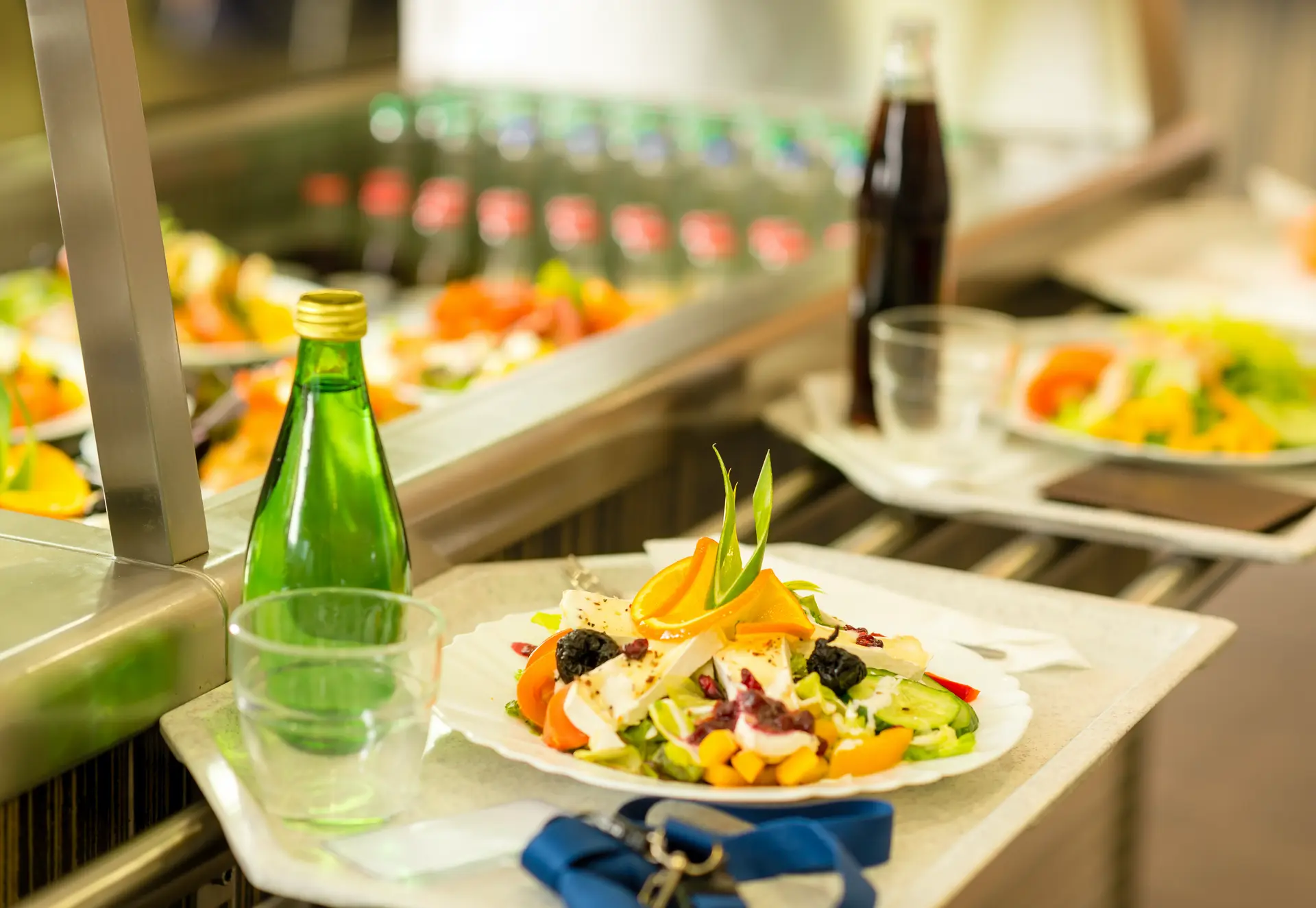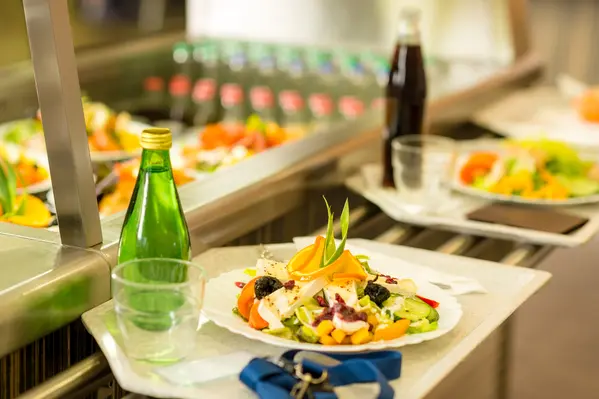
“Zero-Wait” Checkout in Japanese Corporate Cafeterias
From RFID to AI Vision Recognition
The Unique Operations of Corporate Cafeterias
Corporate cafeterias operate differently from typical restaurants. Their primary customers are company employees, often racing against the clock during lunch breaks. As a result, these cafeterias prioritize a “grab-and-go” experience with fast, efficient service. Unlike restaurants that use waiting lines, mobile apps, or tablet-based ordering systems, corporate cafeterias typically follow a streamlined process:
- Picking up meals: Employees take pre-prepared main dishes, soups, side dishes, and/or desserts.
- Checkout: They scan their employee ID or a dedicated card at a self-checkout station, completing the payment almost instantly.
Why Self-Service Works So Well in Cafeterias
The success of self-service in corporate cafeterias rests on two key factors:
- Simple, limited menus
Menus are deliberately short and straightforward to maximize efficiency and reduce costs. Unlike commercial restaurants, corporate cafeterias don’t need complex or highly customizable meal options, creating ideal conditions for automated checkout technology. - Controlled environment and trusted customers
Cafeterias mainly serve their own employees, resulting in a high level of trust and minimizing the risk of accidental or intentional non-payment. This self-disciplined customer base makes implementing self-checkout systems smoother and more reliable.
The simple menu and employee-only customer bas/e make self-service meal pickup feasible. To enable fast and accurate checkout within this setup, cafeterias began adopting RFID and AI vision recognition technologies.

The First Efficiency Revolution: RFID and Plate-Based Checkout
Radio Frequency Identification (RFID) was one of the first technologies explored in Japanese corporate cafeterias to enable automated checkout. Its design cleverly leveraged the cafeteria’s simple menu structure.
How it Works: One Plate, One Tag
- Tagging: Each plate, corresponding to a specific dish and price, contains a unique RFID tag attached or embedded on its bottom.
- Data link: The tag stores information that ties directly to the dish and its price.
- Quick scanning: When an employee places their plate on the self-checkout reader, the system instantly detects all RFID tags and calculates the total amount with almost zero delay.
Pros and Cons of RFID
| Advantages | Extremely fast |
| Reliable | |
| Mature technology | |
| Drawbacks | High setup and maintenance costs: every plate requires a tag, and different plates may need to match different dishes. |
| Low flexibility: adding new dishes or changing the menu requires new plates, tags, and system reconfiguration. | |
| Increased complexity: staff must ensure the right dish is paired with the correct plate, adding extra prep work and operational complexity. | |
| Vendor lock-in: RFID systems (tags, readers, backend) are typically provided by a single POS vendor. If the cafeteria needs to switch providers—or if the original vendor discontinues their service—the entire system, including all tagged plates, may need to be replaced, wasting the initial investment. |
Due to high costs, low flexibility, and vendor lock-in risks, many companies began looking for a more economical and adaptable next-generation solution.
The Second Efficiency Revolution: AI Vision Recognition
AI vision recognition has revolutionized cafeteria checkout by eliminating the need for RFID tags, offering unprecedented flexibility.
How it Works: Visual Recognition of Food
- Image capture: Employees place their plate in a designated area, and a camera snaps an image of the entire plate.
- AI Recognition: AI is able to identify:
- Food items: Recognizing the type and quantity of each dish.
- Tableware: Identifying plate style and size.
- Price calculation: The system combines the recognition results with menu prices to calculate the total amount.
Why AI Vision Outshines RFID
| Advantages | Explanation |
| Low initial cost | No tags or specialized plates needed; only cameras and system installation. Low barrier to entry and requires minimal setup. |
| High operational flexibility | Menus and plate styles are no longer fixed. New dishes or plate designs can be added simply by updating the AI model in the cloud. |
| Low maintenance | No tags to replace; damaged plates can be swapped freely. Cloud-based subscription models make costs predictable. |
| Reduced vendor lock-in | Cloud or standardized hardware reduces dependency on a single provider, minimizing switching costs. |
| Broad applicability | AI can recognize food itself, allowing cafeterias to adapt even if operations change to uniform plate styles. |
Although AI recognition can be slightly slower than RFID—typically 1–2 seconds—the trade-off is well worth the operational flexibility, lower maintenance, and long-term efficiency gains.
The Future of Smart Canteen:
AI-Driven Efficiency and Sustainability
The evolution of checkout in Japanese corporate cafeterias illustrates a shift from hardware-heavy solutions (RFID tags) to software-driven intelligence (AI vision recognition).
While RFID contributed to efficiency in controlled environments, its high cost and limited adaptability make it unsuitable for today’s dynamic workplace canteens.
In contrast, AI vision recognition aligns perfectly with modern operational needs: low cost, high flexibility, and minimal maintenance. It enables “zero-wait” service, rapid adaptation to menu changes, and sustainable canteen management—making it the go-to solution for smart dining operations today.
RFID vs. AI Vision Recognition: Quick Comparison
| Feature | RFID System | AI Vision Recognition |
|---|---|---|
| Hardware requirements | High (tags, readers, plate modifications) | Low (camera only, cloud-based recognition) |
| Initial cost | High | Low |
| Maintenance | High (tag or plate issues) | Low |
| Recognition accuracy | High | Medium-high |
| Flexibility | Low (plate-bound, vendor lock-in, costly to replace) | High (Menu and plates are independent, allowing quick operational adjustments.) |
| Ideal use case | Canteens with fixed menus | Canteens needing frequent menu changes, high operational flexibility, and rapid deployment |
Related Articles:
- AI Revolutionizes Haidilao “Hi Noodle” Self-Checkout Experience
- Real-World Challenges in AI Food Recognition (Part 1)
- Real-World Challenges in AI Food Recognition (Part 2): How AI Identifies Cups and Plates?
- From Retail to Dining: How AI Image Recognition Solves Checkout Challenges for Unpackaged Goods
- 5 Innovative Image Recognition Applications in Food Service
- The Rise of Self-Service Dining in Japan: From Meal Ticket Machines to RFID and AI-Powered Checkout

